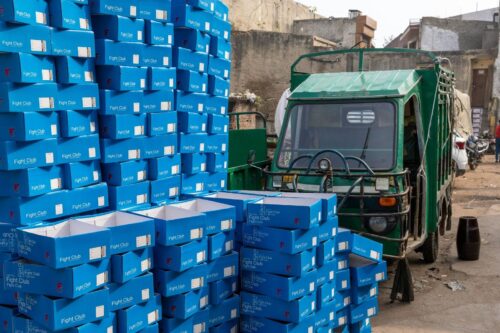Big Box Shipping: Definition, Key Components, and Challenges

Big box shipping is a cornerstone for efficiently transporting large quantities of goods across vast distances. However, you must understand every detail about shipping large boxes or oversized packages and its key components.
With globalization fueling business expansion, there is a growing demand for big box shipping. An oversized package and large box help you deal with substantial inventory volumes. Big box shipping gives you tons of options compared to other shipping methods.
This detailed guide discusses the intricacies of big-box shipping, exploring its definition, key components, and the challenges logistics professionals face.
What is Big Box Shipping?
Big box shipping refers to a specialized method of transporting large quantities of goods, typically using heavy boxes, oversized containers, or pallets, across extensive distances.
Unlike standard shipping options that use smaller volumes and single boxes, big boxes ship large packages. It focuses on handling bulk shipments efficiently. These shipments are often characterized by their substantial size, dimensional weight, and volume. They require specialized equipment and handling procedures for transportation.
In the big-box shipping service, distributors pack goods into large containers. They use crates, pallets, or shipping containers to maximize space utilization and streamline the loading-unloading processes.
This method enables businesses to transport massive quantities of products in fewer shipments. Hence, it is the cheapest shipping method compared to postal or courier services.
Commonly transported goods via big box shipping include large appliances, furniture, electronics, construction materials, and wholesale merchandise. All you need to ensure is the package dimensions, actual weight, and combined length.
Key Components of Big Box Shipping Method

Exploring the foundational elements of big box freight shipping unveils its intricate components. Each contributes to the seamless movement of large-scale cargo across vast distances.
Shipping Containers and Packaging
Big box shipping relies on various containers and packaging solutions tailored to accommodate large volumes of goods. These include sturdy shipping containers, pallets, crates, and specialized packaging materials. These materials protect goods during transit and can withstand the rigors of transportation.
Logistics and Transportation
The logistics and transportation aspect of big box shipping encompasses planning, coordination, and execution. It involves selecting the most efficient transportation methods for moving large volumes of goods, such as cargo ships, freight trains, and long-haul trucks.
Logistics experts strategically optimize routes, schedules, and modes of transportation to minimize transit times and maximize cost-effectiveness. Additionally, advanced tracking and monitoring systems ensure the timely and reliable delivery of big-box shipments.
Challenges in Big Box Shipping
Navigating the landscape of big-box shipping presents several challenges. Each challenge can be resolved with careful consideration and strategic management.
Handling and Storage To Ship Large Boxes
One of the foremost challenges in big box shipping revolves around the efficient handling and free storage of oversized items. Although it is an economical shipping option, managing the logistics of bulky goods requires specialized equipment.
You also need facilities and trained personnel who can safely handle large items. Challenges may arise due to limited storage space, complex handling requirements, and the risk of damage or accidents.
Regulatory Compliance and Security For Oversized Packages
Maintaining regulatory compliance and ensuring security is very important in big-box shipping.
Compliance with various international, national, and local transportation regulations can save you much trouble. If you follow the laws of customs clearance and environmental standards, you can avoid delays, penalties, and legal ramifications during the process.
Additionally, safeguarding big box shipments from theft, tampering, and damage requires robust security measures. You must have secure packaging, tracking systems, and adherence to strict chain of custody protocols throughout the shipping process.
Balancing regulatory compliance and security considerations can reduce risks. It can save money and deliver the shipments to your customers promptly.
Technological Advancements in Big Box Shipping

Technological advancements are revolutionizing big-box shipping. They offer innovative solutions to enhance efficiency, visibility, and tracking throughout shipping.
One significant development is integrating advanced tracking systems powered by the Internet of Things (IoT).
IoT sensors embedded in shipping containers and packages enable real-time monitoring of location, temperature, humidity, and other environmental factors. This granular level of tracking provides shippers with unprecedented visibility into their shipments, allowing them to address delays, route deviations, or damage proactively.
Furthermore, automation can streamline various aspects of big-box shipping operations. Automated handling equipment, such as robotic arms and conveyor systems, optimizes the loading, unloading, and sorting of large items. It reduces manual labor requirements and minimizes the risk of accidents or injuries.
Automation extends to inventory management systems, where technologies like RFID (Radio-Frequency Identification) and barcode scanning facilitate accurate inventory tracking. It ensures you ship the right items to the right destinations at the right times.
Another technological advancement shaping big box shipping is data analytics and artificial intelligence (AI) algorithms. AI algorithms can identify patterns, trends, and inefficiencies by analyzing vast shipping data. Companies can make data-driven decisions to optimize routes and minimize transportation costs.
Best Practices for Effective Big Box Shipping
Effective big box shipping relies on implementing best practices to streamline operations.
- Proactive Inventory Management: Maintain accurate inventory records, anticipate demand fluctuations, and optimize storage space.
- Use Inventory Management Software: Implement software solutions to track inventory levels, streamline order fulfillment, and automate inventory replenishment processes.
- Adopt Just-in-Time Inventory Strategies: Minimize excess inventory and stockouts by replenishing inventory only when needed. It reduces carrying costs and optimizes warehouse space.
- Optimize Transportation Routes: Consolidate shipments, negotiate favorable rates with carriers, and leverage technology solutions for route optimization. It can minimize transportation expenses.
- Implement Freight Management Systems: Incorporate technology platforms to streamline logistics processes and track real-time shipments to optimize freight transportation.
- Try Sustainable Packaging Practices: Use eco-friendly materials, minimize packaging waste, and optimize packaging size and weight. It can reduce shipping costs and environmental impact.
- Ensure Compliance with Regulations: Stay updated on regulatory requirements related to shipping and logistics. This way, you can avoid penalties and disruptions in operations.
- Invest in Training and Development: Train the warehouse staff to enhance their skills, promote safety, and encourage them to adapt to changing industry trends.
Final Thoughts
Big box shipping is pivotal in efficiently transporting large volumes of goods across vast distances. If you are unsure how to deal with substantial inventory volumes, you can seek guidance from industry experts.
USPS Priority Mail can also help ship large volumes. But remember that USPS is limited to the states, while big-box shipping deals with vast distances. Understanding the nuances of big box shipping, including its key components and challenges, can help you ensure smooth operations of large quantities.
